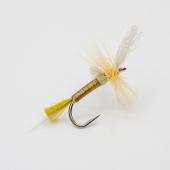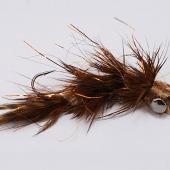Time Flies By
Tools & tactics for a new off-season hobby.
For some, the thought of taking up fly tying is overwhelming, while others just dive in. One of my pupils was only seven when he first attended my free fly-tying class at Gallatin River Guides. This summer, at the age of ten, he sold enough flies at the local farmers' market to purchase the backpack of his dreams.
That being said, it can be intimidating to take the first steps. A person may not know what tools to buy or materials to start with, and then there’s the decision of which flies to tie first.
My advice is to keep it simple. You don’t need the best or the latest and greatest. Buy the best basic tools you can afford. There are tons of tools on the market, but I would start with a vise, bobbin, scissors, and maybe a whip finisher or half-hitch tool.
Tools
A vise holds your hook in position while you tie. I don’t recommend a cheap one; if you can spend at least $80 for a new one, you’ll be better off. Vises with bases allow you to tie just about anywhere, but are not as adjustable or stable as C-clamp models.
Bobbins hold spools of thread while you tie. It doesn’t need to be fancy, but I recommend purchasing one that has either an all-ceramic tube or inserts at each end of the thread tube as it will last longer.
Fly-tying scissors don’t need to be expensive, but they should fit comfortably in your hand, be sharp, and have fine tips for micro-cuts. I prefer spring-loaded scissors that stay in my hand at all times while I’m tying, but they’re not for everyone.
All flies have to be finished with a knot (or multiple knots) so they don’t unravel. A whip finisher offers the most secure finish knot, but comes with a steep learning curve. Half-hitches are much easier to learn and can even be done without a tool, but they’re not as secure. Adding some head cement or thin super glue at the head of your fly will improve durability.
There are dozens of other tools designed to help you with various techniques, but you can always add to your quiver as you make progress
Materials
When it comes to tying specific flies, choose wisely. I recommend starting with some simple patterns that you tend to fish often. For me, those are Pat’s Rubber Legs, soft-hackle pheasant tails, lightning bugs, serendipities, Prince Nymphs, x-caddis, and zebra midges. In the beginning, stay away from dry flies that require hackle. Dry-fly hackle gets expensive quickly and you may learn that you prefer to buy hackled dry flies instead of tying them yourself. Once you have a list of patterns, including colors and sizes, put together a material list. If the list seems overwhelming, then cut down on your number of patterns, or even consider starting with just a single pattern.
You can purchase a basic fly-tying kit, which I don’t necessarily recommend, but Hareline has put together a couple of great kits with good tools and the materials you need to tie a few patterns of their choosing. They’ve even uploaded free how-to videos for each pattern they’ve selected. YouTube is also a great resource for instructional videos, but look for respected channels, such as “In the Riffle.”
Don’t forget to support your local fly shops, many of which offer fly-tying instruction in the off-season and often have knowledgeable fly tiers that are happy to offer guidance as you start tying on your own.
Jimmy “Loosewraps” Armijo-Grover is the general manager of Gallatin River Guides in Big Sky.













